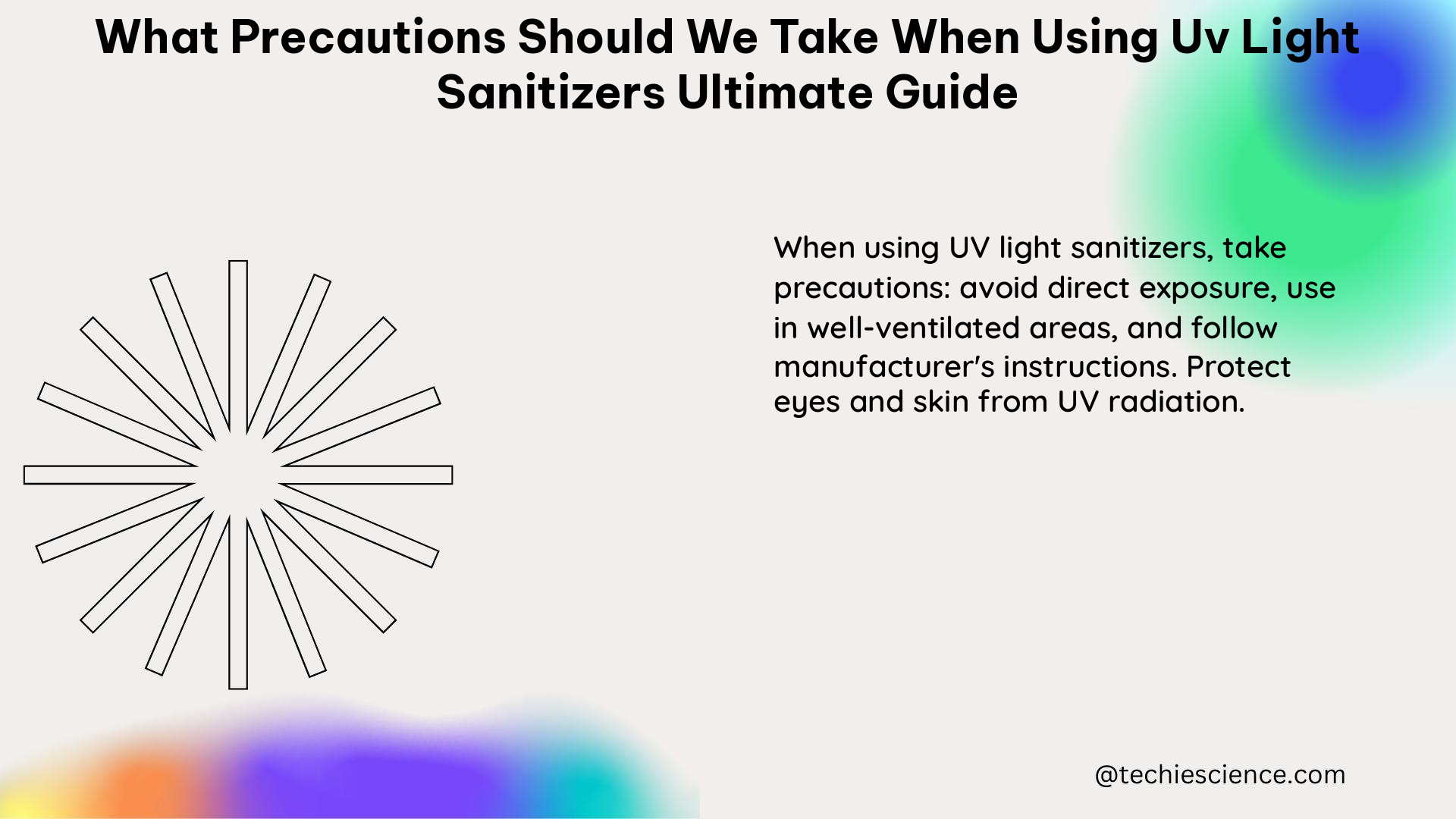UV light sanitizers have become increasingly popular for their ability to disinfect surfaces and air. However, it is crucial to take necessary precautions when using these devices to avoid potential risks to human health and safety. This comprehensive guide will provide you with detailed information on the precautions you should take when using UV light sanitizers.
1. Personal Protective Equipment (PPE)
Eye Protection
Exposure to UV radiation can cause severe eye damage, including photokeratitis (welder’s flash) and photoconjunctivitis. To protect your eyes, you should wear UV-rated eye and face protection, such as polycarbonate face shields and eyeglasses with Z87 marking (ANSI Z87.1 UV certification). These provide protection against UV-A (315-400 nm), UV-B (280-315 nm), and UV-C (100-280 nm) radiation.
Skin Protection
UV radiation can also cause skin damage, including erythema (sunburn), premature aging, and an increased risk of skin cancer. To protect your skin, you should wear long-sleeved, tightly woven clothing that covers much of the body, gloves with no gap between the cuff and the glove, and a hat with a wide brim to shade the face, head, ears, and neck.
Gloves
Use nitrile gloves to protect exposed skin on the hands, ensuring that exposed skin on the wrist and forearms is also covered.
2. Proper Usage

Read the User Manual
Before using a UV light sanitizer, it is essential to read the user manual and understand the device’s instructions and features, including how to turn it on and off, and any built-in safety features.
Install Correctly
Place the UV light sanitizer in an open area with no furniture blocking the light to maximize its sanitizing capabilities. Ensure that the device is installed at the appropriate height and distance from the target surface or area to be disinfected.
Timing
Use the UV light sanitizer before and after multiple people have been in the room to optimize its effectiveness. The duration of use should be based on the manufacturer’s recommendations and the size of the room or area being disinfected.
Avoid Direct Exposure
Ensure that no one, including pets, is present in the room while the UV light sanitizer is operating. Exposure to direct UV radiation can be harmful to human health.
3. Maintenance and Monitoring
Bulb Maintenance
Wipe UV bulbs monthly with a soft cloth dampened with ethanol when the bulb is not operating and is cool to the touch. This helps to maintain the bulb’s efficiency and prevent the buildup of contaminants.
Bulb Replacement
Replace UV bulbs annually or as recommended by the manufacturer. Over time, the bulb’s output and disinfection capabilities may decrease, reducing the effectiveness of the UV light sanitizer.
4. Signage and Access Control
Warning Signs
Post warning signs on entrances to the room or on the biosafety cabinet, stating “Caution: High Intensity Ultraviolet Energy. Protect Skin and Eyes”. This helps to inform people about the potential hazards and the need for appropriate PPE.
Access Control
Strictly control access to the room while the UV lamp is operating to prevent exposure. Ensure that only authorized personnel are allowed to enter the room during the disinfection process.
5. Avoidance of Direct UV Light Exposure
Do Not Look Directly at the Lamp
Avoid direct eye exposure to the UV lamp to prevent eye damage, such as photokeratitis (welder’s flash) and photoconjunctivitis.
Avoid Skin Exposure
Prevent skin exposure to UV radiation to avoid burns and other biological effects, such as erythema (sunburn) and premature aging.
6. Alternative Methods
Chemical Disinfection
In some cases, it may be more appropriate to use chemical disinfectants for surface disinfection, especially for organisms that require specific disinfectants.
7. Regulatory Compliance
FDA Guidelines
Follow the FDA guidelines and recommendations for UV light sanitizers, including avoiding the use of UV wands that give off unsafe levels of radiation.
8. Training and Supervision
Training
Ensure that personnel are trained on the safe and proper use of UV light sanitizers and biological safety cabinets. This includes understanding the potential hazards, the importance of PPE, and the correct operating procedures.
Supervision
Ensure that the Principal Investigator (PI) is responsible for ensuring that personnel under their supervision are trained and follow the correct decontamination procedure.
By following these precautions, you can ensure the safe and effective use of UV light sanitizers in your facility.
References:
– https://www.ehs.washington.edu/system/files/resources/uv-safety.pdf
– https://www.fda.gov/medical-devices/safety-communications/do-not-use-ultraviolet-uv-wands-give-unsafe-levels-radiation-fda-safety-communication
– https://izakscientific.com/safety-tips-for-using-uv-light-sanitizers/
– https://www.safety.rochester.edu/ih/uvlight.html
– https://www.unmc.edu/ehs/safety/UVHazardsSafetyGuideline.pdf

The lambdageeks.com Core SME Team is a group of experienced subject matter experts from diverse scientific and technical fields including Physics, Chemistry, Technology,Electronics & Electrical Engineering, Automotive, Mechanical Engineering. Our team collaborates to create high-quality, well-researched articles on a wide range of science and technology topics for the lambdageeks.com website.
All Our Senior SME are having more than 7 Years of experience in the respective fields . They are either Working Industry Professionals or assocaited With different Universities. Refer Our Authors Page to get to know About our Core SMEs.